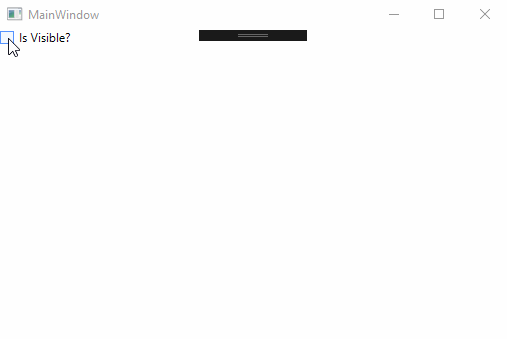Apply animation on WPF control visibility change
Eventtrigger
<DockPanel Background="#bdbec0" MouseEnter="showTopMenu_MouseEnter" HorizontalAlignment="Stretch" Height="55" >
<DockPanel.Triggers>
<EventTrigger RoutedEvent="DockPanel.MouseEnter">
<BeginStoryboard>
<Storyboard>
<DoubleAnimation Storyboard.TargetProperty="Opacity" Storyboard.TargetName="TopMenuArea"
From="0.0" To="1.0" Duration="0:0:1"></DoubleAnimation>
</Storyboard>
</BeginStoryboard>
</EventTrigger>
<EventTrigger RoutedEvent="DockPanel.MouseLeave">
<BeginStoryboard>
<Storyboard>
<DoubleAnimation Storyboard.TargetProperty="Opacity" Storyboard.TargetName="TopMenuArea"
From="1.0" To="0" Duration="0:0:1"></DoubleAnimation>
</Storyboard>
</BeginStoryboard>
</EventTrigger>
</DockPanel.Triggers>
<Button HorizontalAlignment="Center" VerticalAlignment="Center">Down</Button>
</DockPanel>
<DockPanel Background="#151515" LastChildFill="True" Visibility="Collapsed" Opacity="0" Name="TopMenuArea" Height="55">
</DockPanel>
Or use a style for fade in and out (with mouse enter / exit eventhandler like you did it)
<Style TargetType="FrameworkElement" x:Key="VisibleAnimation">
<Setter Property="Visibility" Value="Collapsed"/>
<Setter Property="Opacity" Value="0"/>
<Style.Triggers>
<Trigger Property="Visibility" Value="Visible">
<Trigger.EnterActions>
<BeginStoryboard>
<Storyboard>
<DoubleAnimation Storyboard.TargetProperty="Opacity"
From="0.0" To="1.0" Duration="0:0:0.2"/>
</Storyboard>
</BeginStoryboard>
</Trigger.EnterActions>
</Trigger>
</Style.Triggers>
</Style>
<DockPanel Background="#151515" LastChildFill="True" Style="{StaticResource VisibleAnimation}" Name="TopMenuArea" Height="55">
Just define the style in your App Resources, or in the local Window or UserControl. You reuse the Animation style for any control.
use this in your Stackpanel
<StackPanel Background="Red" HorizontalAlignment="Stretch" >
<StackPanel.Triggers>
<EventTrigger RoutedEvent="StackPanel.MouseLeftButtonDown" >
<BeginStoryboard>
<Storyboard>
<DoubleAnimation Storyboard.TargetProperty="Opacity" Storyboard.TargetName="TopMenuArea"
From="1.0" To="0" Duration="0:0:1"></DoubleAnimation>
<ObjectAnimationUsingKeyFrames Storyboard.TargetName="TopMenuArea"
Storyboard.TargetProperty="Visibility">
<DiscreteObjectKeyFrame KeyTime="0:0:2" Value="{x:Static Visibility.Collapsed}"/>
</ObjectAnimationUsingKeyFrames>
</Storyboard>
</BeginStoryboard>
</EventTrigger>
</StackPanel.Triggers>
<Label HorizontalAlignment="Center">Area outside top panel . Clicking here will hide top panel again</Label>
</StackPanel>
It's an old question, but I've put together an open source library to allow fading and/or translation on Visibility changed, Loaded or binding.
You can find it at SciChart.Wpf.UI.Transitionz on Github and on NuGet.
Usage:
<Window x:Class="WpfApplication15.MainWindow"
xmlns="http://schemas.microsoft.com/winfx/2006/xaml/presentation"
xmlns:x="http://schemas.microsoft.com/winfx/2006/xaml"
xmlns:d="http://schemas.microsoft.com/expression/blend/2008"
xmlns:mc="http://schemas.openxmlformats.org/markup-compatibility/2006"
xmlns:tz="http://schemas.abtsoftware.co.uk/transitionz"
mc:Ignorable="d"
Title="MainWindow" Height="350" Width="525">
<Window.Resources>
<BooleanToVisibilityConverter x:Key="b2vc"></BooleanToVisibilityConverter>
</Window.Resources>
<Grid>
<CheckBox x:Name="CheckBox" Content="Is Visible?" IsChecked="False"></CheckBox>
<TextBlock Text="Hello World!" FontSize="44" HorizontalAlignment="Center" VerticalAlignment="Center"
Visibility="Collapsed"
tz:Transitionz.Opacity="{tz:OpacityParams From=0, To=1, Duration=200, TransitionOn=Visibility}"
tz:Transitionz.Translate="{tz:TranslateParams From='10,0', To='0,0', Duration=200, TransitionOn=Visibility}"
tz:Transitionz.Visibility="{Binding ElementName=CheckBox, Path=IsChecked, Converter={StaticResource b2vc}}"/>
</Grid>
</Window>
Which results in:

here is a sample example
<Grid DockPanel.Dock="Top">
<DockPanel Background="#bdbec0"
x:Name="topPanel"
HorizontalAlignment="Stretch"
Height="55">
<Button HorizontalAlignment="Center"
VerticalAlignment="Center">Down</Button>
</DockPanel>
<DockPanel Background="#151515"
LastChildFill="True"
Name="TopMenuArea"
IsHitTestVisible="False"
Height="55">
<TextBlock Foreground="White"> some controls here in a horizontal strip , by default its hidden and when some one click on top button its visible and it wil be hidden when some one click outside this area</TextBlock>
<DockPanel.Style>
<Style TargetType="DockPanel">
<Setter Property="Opacity"
Value="0" />
<Style.Triggers>
<DataTrigger Binding="{Binding IsMouseOver,ElementName=topPanel}"
Value="true">
<Setter Property="Opacity"
Value="1" />
</DataTrigger>
</Style.Triggers>
</Style>
</DockPanel.Style>
</DockPanel>
</Grid>
in the sample above I have set IsHitTestVisible="False" on the TopMenuArea dockPanel, as i can see that it is on top of previous (source for trigger panel)
other option is to use the TopMenuArea as the source if it is on the top
sample
<Grid DockPanel.Dock="Top">
<DockPanel Background="#bdbec0"
HorizontalAlignment="Stretch"
Height="55">
<Button HorizontalAlignment="Center"
VerticalAlignment="Center">Down</Button>
</DockPanel>
<DockPanel Background="#151515"
LastChildFill="True"
Name="TopMenuArea"
Height="55">
<TextBlock Foreground="White"> some controls here in a horizontal strip , by default its hidden and when some one click on top button its visible and it wil be hidden when some one click outside this area</TextBlock>
<DockPanel.Style>
<Style TargetType="DockPanel">
<Setter Property="Opacity"
Value="0" />
<Style.Triggers>
<Trigger Property="IsMouseOver"
Value="true">
<Setter Property="Opacity"
Value="1" />
</Trigger>
</Style.Triggers>
</Style>
</DockPanel.Style>
</DockPanel>
</Grid>
give it a try and see if it is close to what you are looking for.
both of above just switch the opacity between 0 & 1, you may also use animation to make a fade effect if needed.
This would be a good start. You can just add one c# file and set property like below.
common:VisibilityAnimation.AnimationType="Fade"